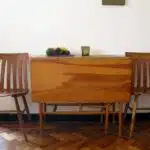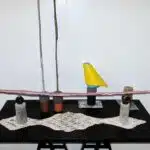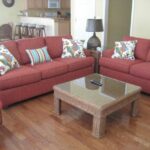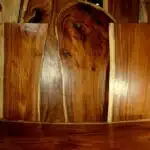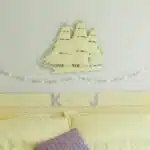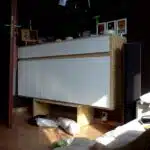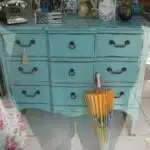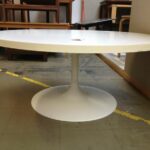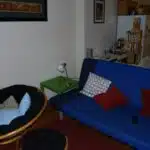Sofa tables are versatile pieces of furniture that can be used to enhance the functionality and style of any living space. However, purchasing a sofa table from a store can be an expensive endeavor, especially if you have specific design requirements. The good news is that with some basic woodworking skills and the right tools, you can create a beautiful and functional sofa table at home for a fraction of the cost. In this article, we will guide you through the process of making a basic DIY sofa table that will elevate your living room décor while providing ample surface area for your belongings.
To begin with, it is essential to have a clear idea of what kind of sofa table you want to create. You may choose to opt for a traditional design or go for something more modern depending on your personal taste and existing décor. Once you have decided on the design, it’s time to gather all the necessary materials and tools such as wood boards, nails or screws, saws, sandpaper, and paint or varnish. With these materials in hand and our step-by-step instructions, you’ll be able to make a beautiful DIY sofa table that meets both your practical needs and aesthetic preferences. So why wait? Follow along as we show you how to make your own custom-made sofa table today!
Choosing The Right Design For Your Sofa Table
Design tips and material selection are two essential aspects to consider when making a DIY sofa table. You have to decide on the design that fits your sofa and the overall theme of your living room. Some popular sofa table designs include traditional, industrial, modern, and rustic styles. You can browse online or visit furniture stores for design inspirations.
Once you’ve chosen a design, it’s time to select the materials for your sofa table. Wood is a popular choice for building furniture due to its durability, versatility, and aesthetic appeal. You can use reclaimed wood or purchase new lumber from hardware stores. The type of wood you choose will affect the appearance and durability of your sofa table. For instance, oakwood is sturdy but expensive, while pine is affordable but soft.
When selecting materials, also consider the tools you’ll be using in building your DIY sofa table. Basic tools such as saws, hammers, nails/screws, sandpapers are necessary for any woodworking project. If you plan to use power tools like a circular saw or drill press, make sure you have experience using them safely.
Now that you’ve learned some design tips and material selection ideas let’s move on to measuring and cutting the wood boards needed for your DIY sofa table.
Measuring And Cutting The Wood Boards
Accurately measuring the wood boards is essential to ensuring that the DIY sofa table will be properly constructed. Cutting the wood boards should be done with a saw that is appropriate for the type of wood being used. Marking the wood boards for assembly should be done with a pencil, tape measure, and a square. Sanding the wood boards after cutting and before assembly should be done with sandpaper and safety glasses.
Measuring
Precise measurements are crucial when constructing a DIY sofa table. Failure to measure accurately can result in a piece that is too small or too large for its intended space. One of the most common measuring mistakes is failing to account for the thickness of the wood boards used in construction.
To avoid this mistake, it’s important to take precise measurements and factor in the thickness of the wood when cutting pieces to size. It may seem like an extra step, but taking the time to make precise measurements will ultimately save time and frustration down the line.
Another common mistake when measuring is relying on eyeballing instead of using a tape measure or ruler. While it may seem quicker, eyeballing can lead to uneven cuts and crooked pieces. Always use a measuring tool and double-check your measurements before making any cuts.
Cutting
When it comes to building a DIY sofa table, precise measurements are just the first step. Cutting the wood boards to size is equally important in ensuring that the final product fits its intended space and looks professional. There are various cutting techniques that can be used, including using a saw or a circular saw. However, it’s crucial to take safety precautions when cutting, such as wearing protective gear like goggles and gloves and making sure the work area is clear of debris.
Before making any cuts, it’s essential to double-check your measurements and mark the wood boards accordingly. This will help you to avoid mistakes and ensure that each piece is cut precisely. When using a saw, it’s important to make slow, deliberate cuts and avoid rushing through the process. Taking your time will result in clean cuts that fit together seamlessly.
When working with power tools like a circular saw, it’s crucial to follow all safety guidelines provided by the manufacturer. This includes keeping your fingers away from the blade and never reaching over or across the saw while it’s in use. Additionally, always unplug the saw before changing blades or making adjustments to prevent accidental injury. By taking these precautions and using proper cutting techniques, you can create a beautiful DIY sofa table that will look great in any room of your home.
Sanding The Wood For A Smooth Finish
To achieve a smooth finish on your DIY sofa table, sanding the wood is an essential step. This process involves removing any rough spots or imperfections from the surface of the wood to make it feel soft and polished. It can also help prepare the material for further treatment, such as staining or painting.
Before starting, you need to choose the right type of sandpaper for your project. There are different grits available, ranging from coarse to fine, and each one serves a specific purpose. For example, if you’re working with rough lumber or want to remove paint or stains from the surface, you may need a lower grit like 60 or 80. On the other hand, if you’re looking for a smoother finish and want to eliminate scratches or blemishes, higher grits like 120 or 220 would be more appropriate.
When sanding your DIY sofa table, it’s important to use proper techniques to ensure optimal results. Start by using long strokes along the grain of the wood with light pressure. Avoid applying too much force as this can damage the surface and create uneven areas. Be sure to sand every part of the table evenly so that it looks consistent when finished. Finally, make sure that you wipe down all surfaces with a clean cloth after sanding to remove any dust particles before moving on to other steps.
- Wear protective gear like gloves and goggles when sanding.
- Use a sanding block or tool for accuracy and consistency.
- Always start with lower grits first before moving onto higher ones.
- Take breaks in between sanding sessions to avoid fatigue and injury.
With these tips in mind, you’ll be able to achieve a smooth finish on your DIY sofa table without any hassle! Next up is assembling the table legs which will be covered in detail in the subsequent section.
Assembling The Table Legs
After sanding the wood, it is time to move onto the next step of creating a basic DIY sofa table: assembling the table legs. Before beginning this step, consider the leg height options available. The height will depend on personal preference and the height of your sofa. A common option is 28 inches for a standard-height sofa, but you may need to adjust accordingly.
Once you have decided on the leg height, it is time to assemble them. Use screws to attach the brackets to each leg and then attach them securely to the tabletop. At this point, you may want to use staining techniques to give your sofa table a personalized touch.
Staining techniques can add color and depth to your piece while also protecting it from wear and tear. Consider using a water-based stain for easy application and cleaning. After staining, allow ample drying time before attaching the legs to the tabletop. With proper assembly and finishing touches complete, your DIY sofa table is ready for use! In the following section, we will discuss how to attach the legs to the tabletop for a sturdy and reliable piece of furniture.
Attaching The Legs To The Tabletop
Now that you have your tabletop and legs prepared, it’s time to attach the legs to the table. There are several leg attachment techniques that you can use, but for this DIY project, we recommend using corner brackets. These brackets are easy to install and provide a sturdy connection between the legs and tabletop. Make sure to choose brackets that are strong enough to support the weight of your table.
Before attaching the legs, consider the height of your sofa and adjust the leg length accordingly. You want your table to be at a comfortable height when seated on the sofa. Typically, a good rule of thumb is to make sure the table is around 1-2 inches shorter than the armrests of your sofa. Once you have determined the correct height for your table, mark where you want each leg to be attached on the underside of your tabletop.
To attach the legs using corner brackets, first, position each bracket in place on one of your marked spots under your tabletop. Next, use screws or bolts (depending on what is provided with your bracket) to secure each bracket into place. Finally, attach each leg onto its corresponding bracket with screws or bolts as well.
- As you attach each leg onto its corresponding bracket, take a moment to appreciate how far you’ve come in this DIY journey.
- Remember why you started this project in the first place and let that motivate you towards completion.
- Think about how satisfied you will be once it’s finished and how proud you will feel knowing that you made it yourself.
Now that your legs are securely attached to your tabletop, it’s time to move on to reinforcing the structure by adding braces underneath. This will ensure that your sofa table can withstand heavy items without wobbling or collapsing under their weight. Let’s dive into how exactly we can reinforce our table with braces without compromising on style or design – keep reading!
Reinforcing The Tabletop With Braces
To add extra stability to the sofa table, reinforcing the tabletop with braces is a crucial step. Using wood glue, attach two wooden braces underneath the tabletop, perpendicular to the table legs. This will prevent any wobbling or bending of the tabletop over time, especially if heavy items are placed on it.
Before attaching the braces, measure and mark where they should be placed. Make sure they are evenly spaced out and centered under the tabletop. Then apply a generous amount of wood glue to each brace before securing them in place with screws. Allow the glue to dry completely before moving on to the next step.
Reinforcing your sofa table with braces not only adds extra stability but also prolongs its lifespan. Without proper reinforcement, your DIY sofa table may not withstand everyday use and wear-and-tear. In the next section, we will discuss how to sand down the table for a uniform look that will enhance its aesthetic appeal.
Sanding The Table For A Uniform Look
As we move onto the next step in creating our DIY sofa table, it’s important to consider the final aesthetics of the piece. Reinforcing the tabletop with braces was crucial for ensuring stability and durability, but now it’s time to make sure that the surface is smooth and uniform. As with any woodworking project, sanding is an essential part of achieving a professional-looking finish.
When it comes to choosing grits for sanding, start with a coarser grit, such as 80 or 100, to remove any rough spots or imperfections on the surface. Then gradually move up to finer grits, like 120 or 150, for a smoother finish. Remember to always sand in the direction of the wood grain and avoid applying too much pressure, as this can create uneven patches.
There are various sanding techniques you can use depending on your preference and available tools. Hand sanding is effective for small areas or intricate details, while power tools like orbital sanders can speed up the process for larger surfaces. Whatever method you choose, take your time and make sure you’ve covered every inch of the tabletop before moving on to applying a stain or paint finish.
Applying A Stain Or Paint Finish
Applying a Stain or Paint Finish:
Once the table is sanded, it’s time to apply a stain or paint finish. Color choices are endless, so select one that complements your decor. If you’re going for a rustic look, consider using darker stains like walnut or mahogany. For a more contemporary look, stick with lighter shades like oak or maple.
When applying the stain or paint, there are several techniques you can use for a professional look. Here are four items to keep in mind:
- Apply the stain/paint with long strokes in the direction of the wood grain.
- Use a foam brush for even coverage.
- Wipe away excess stain/paint with a clean cloth.
- Consider applying multiple coats for optimal coverage and durability.
With these tips in mind, you’ll be able to achieve the perfect finish for your DIY sofa table. Next up, we’ll discuss how to add decorative elements to make your table truly unique and personalized!
Adding Decorative Elements
Now that your basic sofa table is complete, it’s time to add some decorative elements to make it look more attractive. One way to do this is by incorporating greenery into the design. Plants not only enhance the overall aesthetics of a room, but they also have health benefits such as purifying the air.
You can place potted plants on top of your sofa table or use hanging plants to add a touch of nature to your living space. Another way to spruce up your diy sofa table is by using lighting accents. You can choose from a variety of options such as fairy lights, candles or lanterns, and even string lights.
Lighting accents provide an excellent source of ambient lighting and can help create a cozy atmosphere in any room. By incorporating these decorative elements into your diy furniture project, you’ll be able to create a unique and inviting space that reflects your personal style and taste. In the next section, we’ll cover how to install drawer pulls or knobs onto your finished sofa table for added functionality and convenience.
Installing Drawer Pulls Or Knobs
When it comes to installing drawer pulls or knobs on your DIY sofa table, choosing the right hardware is crucial. The hardware you choose can make a significant difference in how your finished piece looks and functions. There are many different types of drawer pulls and knobs available, so it’s essential to take some time to consider what will work best for your specific project.
One option for those looking for a unique touch is to explore DIY alternatives to traditional drawer pulls. For example, you might use pieces of old leather belts or repurpose vintage doorknobs as drawer handles. This approach allows you to put your own spin on the design while also saving money on expensive hardware.
Once you’ve chosen your hardware, it’s time to install it onto your DIY sofa table. Using a template or guide can be helpful in ensuring that all holes are drilled in the correct place. Take special care when attaching the screws to avoid damaging the wood. With a little bit of patience and attention to detail, you’ll have beautiful new drawer pulls or knobs that perfectly complement your handmade furniture piece.
As you finish up installing your drawer pulls or knobs, you may want to start considering creating a shelf or storage space on your DIY sofa table. This additional feature can add both functionality and visual appeal to your piece. Keep reading for more tips on incorporating shelves into your handmade furniture projects without breaking the bank.
Creating A Shelf Or Storage Space
Now that you have successfully installed your drawer pulls or knobs, it’s time to move on to the next step in creating your DIY sofa table. One of the great things about making your own furniture is the ability to customize it to fit your specific needs and style preferences. In this section, we will be discussing how to create a shelf or storage space for your sofa table.
When it comes to DIY sofa table styling, one important aspect to consider is maximizing storage. A shelf underneath the tabletop can provide a convenient space for storing books, magazines, or other items you like to keep within reach while lounging on the couch. To create a shelf, measure and cut a piece of wood that fits between the legs of your table frame. Use pocket holes or brackets to attach the shelf securely.
Another option for maximizing storage is adding drawers or baskets underneath your DIY sofa table. This can be especially useful if you have limited space in your living room and need extra storage options. Consider using drawer slides for smooth operation, and choose baskets or containers that match the style of your table for a cohesive look. With these simple additions, you can make the most out of your DIY sofa table and create a functional piece that not only looks great but also serves practical purposes.
Now that we’ve discussed how to add storage space to your DIY sofa table, let’s move on to another way you can enhance its functionality – by adding wheels or casters for mobility. This will allow you to easily move the table around as needed and make cleaning underneath it a breeze. Whether you choose industrial-style casters or sleek modern ones, this addition will give your sofa table an extra layer of versatility while still maintaining its stylish appearance.
Adding Wheels Or Casters For Mobility
DIY caster options are plentiful and offer an array of benefits for your mobile sofa table. When looking for the best DIY caster options, it is important to consider the weight capacity and size of your sofa table. This will ensure that you select the appropriate casters necessary to support the weight and size of your table.
The benefits of a mobile sofa table are endless. With casters, you can easily move your sofa table from one room to another, allowing it to serve multiple purposes. You can also rearrange furniture with ease, making it easy to accommodate different seating arrangements or rearrange your living space according to your preferences.
Proper maintenance will ensure that your DIY sofa table lasts for many years. One important tip is to regularly clean the casters by wiping them down with a damp cloth. Additionally, make sure that the casters are tightened properly to prevent any wobbling or instability. With these simple tips, you can enjoy all the benefits of a mobile sofa table without worrying about any wear and tear over time.
Tips For Proper Maintenance
Cleaning is an important part of proper maintenance for any diy sofa table. It is important to dust the table regularly and use a damp cloth for deeper cleaning.
Polishing the table on a regular basis is also important for maintaining the finish. Using a soft cloth, apply a quality furniture polish to help keep the finish looking its best.
Repairing any damage to the table should be done as soon as possible. This will help keep the table structurally sound and looking its best.
Any loose screws should be tightened regularly to ensure the table is properly constructed.
It is important to check for any signs of wear or damage to the table on a regular basis.
Finally, if there are any major repairs that need to be done, it is best to consult a professional for advice.
Cleaning
Keeping your DIY sofa table clean is essential in ensuring its longevity and durability. Here are some cleaning tips that will help you maintain the pristine condition of your furniture piece for years to come. First, always use a soft cloth or sponge when wiping down the surface. Avoid using abrasive materials such as steel wool or harsh chemicals that can damage the wood’s finish. Instead, opt for mild soap and warm water to remove any dirt or stains.
Second, make sure to clean up spills immediately. Liquids can seep into the wood and cause irreparable damage if left unattended. Dab the affected area with a dry cloth first to absorb as much liquid as possible, then follow up with a damp cloth to remove any remaining residue.
Lastly, avoid placing your DIY sofa table in direct sunlight or areas with high humidity levels. These environmental factors can cause warping, cracking, and discoloration over time. Instead, position your furniture piece in a well-ventilated area and use a dehumidifier if necessary.
By following these maintenance tricks and cleaning tips, you’ll be able to keep your DIY sofa table looking brand new for years to come. Remember that proper care and attention are key to preserving the beauty and functionality of your furniture piece.
Polishing
Maintaining the beauty and functionality of your DIY sofa table requires proper care and attention. Aside from keeping it clean, polishing is also a vital part of maintaining its pristine condition. Using different polishing techniques can help enhance the wood’s natural shine and protect it from wear and tear.
Choosing the right type of polish for your table is crucial in achieving optimal results. Some polishes contain harsh chemicals that can strip off the wood’s finish or cause discoloration over time. Make sure to read the label carefully before purchasing and opt for polishes that are specifically designed for your type of wood.
When polishing, always use a soft cloth or microfiber towel to apply the polish evenly. Start in small sections and work your way around the table until you’ve covered every inch of its surface. Make sure to buff it out with a clean cloth afterward to remove any excess residue. By incorporating regular polishing into your maintenance routine, you can ensure that your DIY sofa table remains beautiful and functional for years to come.
Repairing
Proper maintenance is essential to ensure that your DIY sofa table remains in top condition for many years. Polishing the table is just one part of the maintenance routine. Another crucial aspect is repairing any damages that may occur to the table over time. Fortunately, repairing a sofa table is an easy task that you can do by yourself with the right tools and materials.
If your sofa table has scratches, dents, or chips, don’t panic; these can be easily fixed. You will need some sandpaper or a sanding block to smooth out any rough edges or surfaces on the table. Next, apply filler material to fill in any gaps or cracks in the wood. Once dry, sand it down again until it’s level with the rest of the surface.
If there are deeper damages such as broken legs or damaged joints, you will need different tools and materials for repair. For instance, if a leg breaks off from your sofa table, you can use clamps and wood glue to reattach it firmly into place. It’s important to let it dry completely before removing the clamps and using it again. These simple repairs not only keep your DIY sofa table functional but also help prolong its lifespan for years of enjoyment to come.
Troubleshooting Common Issues
Despite your best efforts, sometimes things do go wrong during a DIY project. Even the simplest of projects, like building a DIY sofa table, can present its own set of challenges. However, it’s important to remember that these issues are not insurmountable and with a little bit of patience and perseverance, you can overcome them.
One common issue that DIYers encounter when building a sofa table is wobbling legs. This can be frustrating, especially if you’ve put in a lot of effort into the build. However, fixing wobbling legs is relatively simple. One solution is to use furniture pads underneath each leg to even out any unevenness in the floor. Alternatively, you can try adding some additional support to the legs by installing extra brackets or braces.
Another common issue that arises when building a sofa table is dealing with an uneven tabletop. This can happen due to various reasons such as incorrect measurements or the use of unlevel materials. To fix this problem, you can try sanding down any high spots on the tabletop or adding shims under the legs to level it out. If all else fails, you may need to disassemble the table and start again from scratch.
While troubleshooting common issues during a DIY project can be frustrating at times, it’s important to remember that these are all part of the learning process. By taking steps to fix any problems that arise during your build, you’ll not only end up with a beautiful finished product but also gain valuable knowledge and experience for future projects. With your sofa table built and any issues resolved, it’s time for the fun part – showcasing your creation in your living space!
Showcasing Your Diy Sofa Table In Your Living Space
To truly showcase your DIY sofa table, it’s important to focus on the details. Arranging accessories can elevate the look of any piece of furniture, and your sofa table is no exception. Consider adding a vase of fresh flowers or a decorative bowl filled with fruit to bring color and life to the space. You could also display books or other decorative objects that complement your existing decor.
Lighting options also play a crucial role in highlighting your DIY sofa table. Adding a lamp or two can create a cozy atmosphere and draw attention to the table as a focal point in the room. Alternatively, you could install wall sconces above the table for a more dramatic effect. If you’re feeling adventurous, string lights or LED strips could be used underneath the table for a unique touch.
Overall, showcasing your DIY sofa table is all about being creative and making it work within your existing living space. Experiment with different accessory and lighting options until you find what works best for you. With some careful planning and attention to detail, your DIY sofa table will become an eye-catching centerpiece in no time!
Conclusion
In conclusion, creating a basic DIY sofa table can be a fun and rewarding project for any furniture enthusiast. By following the steps outlined above, you can design and build a functional piece to complement your living space. Remember to choose a design that suits your style and space requirements, measure and cut the wood with precision, sand the surfaces for a smooth finish, assemble the legs carefully, and attach them securely to the tabletop.
To add mobility to your sofa table, consider adding wheels or casters for ease of movement. Proper maintenance is also essential for keeping your DIY sofa table in good condition. Troubleshooting common issues such as wobbling or unevenness can help you perfect your creation. Finally, showcase your DIY sofa table in your living space with pride and enjoy the satisfaction of having created something beautiful and practical all on your own. As they say, “home is where the heart is,” so let this DIY project be an expression of that love!
Image Credits


